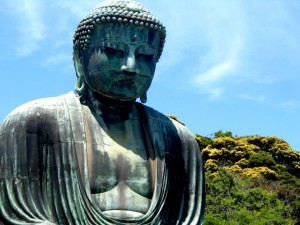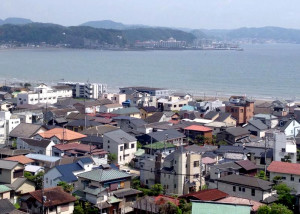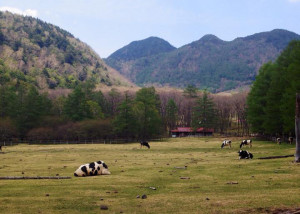Student Spotlight: Rachel Stopchinski on Japan and Sankai Juku
Editor’s note: Rachel Stopchinski is a student at the University of Michigan and part of our UMS student intern team. This summer, Rachel traveled to Japan as part of a study abroad program through the University of Michigan. Her travel blog follows, and her experiences include reflections on Sankai Juku, a Japanese dance group performing in Ann Arbor this October.

Photo: A moment from UMUSUNA: Memories Before History, a work by the Japanese company Sankai Juku, who perform in Ann Arbor October 23-24, 2015. Photo courtesy of the artist.
This past May, I had the opportunity to travel to Tokyo, Japan, my second study abroad program in my undergraduate years. This program followed a class I’d taken on Environmental History. As part of the class, my classmates and our professor were going to participate in experiential learning and exploration. After studying in Tokyo for a month the year prior, I was excited to see what adventures this trip would bring me. However, I knew that neither of these trips would’ve been possible without my exposure to international theater through my internship in the UMS ticket office.
Inspired to Learn by Performance
In its 2013-2014 season, UMS presented Complicite’s A Portrait of Shun-kin, a contemporary theater work. While working in the ticket office, students familiarize themselves with upcoming performances. A Portrait of Shun-kin was one of those performances that seemed so unusual that I had to attend to grasp what it was about. Based on Tanizaki Junichiro’s novella of the same title, the performance was performed in Japanese by the Setagaya Public Theater with English subtitles and made heavy use of puppetry and highly-contrasted stage lighting. Although the performance was three hours long, I didn’t notice time passing and was spell-bound by the performance’s intensity. I walked away that night painfully aware of how little I knew about the world and of the small scope of literature that had been covered in the English courses I’d chosen so far. Coincidentally, this is when I heard about a new study abroad program focused on reading modern Japanese literature in translation…It was fate. Had I not had that exposure through A Portrait of Shun-kin, I don’t believe I would’ve found myself in Tokyo that following year with a growing interest in Japanese culture and history. In literature, context is everything, and I wanted to explore Japanese history in a practical way.
Left: Daibutsu at Koto-kuin, a Buddhist Temple in Kamakura, Japan. Right: A view of the seaside in Kamakura, Japan.
Returning to Tokyo
For me, returning to Tokyo for the second time brought the realization that while one may leave a place, one never really forgets it. I’d spent my time on my first trip freely exploring the city, so during the second trip, I easily adapted to using the trains and metro again. (I even felt a little nostalgic.) But though my directional memory was spot on, the second trip came after one more year of learning about Japan, so I viewed the city through a different lens.
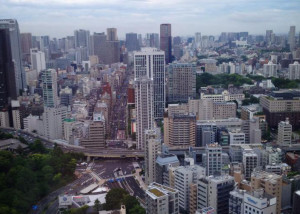
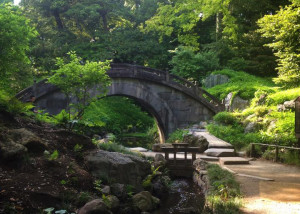
Left: The Tokyo skyline as seen from Tokyo Tower contrasted with Right: A serene bridge inside Koishikawa Korakuen, a traditional Japanese garden in Tokyo.
Through my Environmental History course, we studied the effect of environmental issues on Japanese culture and history over time. During my time in Japan, we interacted with many people, from university students to filmmakers, non-profit organizations, and even government officials at a waste processing site, all with the purpose of learning about the environmental issues. During the program, we moved to and from the countryside, meeting guides who taught us about the unique history and traditions of the places we visited and highlighted the longstanding relationship with the environment, both its great beauty and the effects of devastating pollution and disasters. We explored the harmony and disharmony between humans and nature.
Left: A pastoral scene found while hiking in Nikko, Japan. Right: Basking in the beauty of Lake Chuzenji from a swan boat.
Back to Performance
When looking at the description for UMS’s upcoming presentation of Sankai Juku’s UMUSUNA: Memories Before History, I think about hiking in ancient, old growth forest in the “sea of trees” at the base of Mt. Fuji. My class was spending the weekend in Fujinomiya, Japan at the Whole Earth Nature School, an organization that facilitates groups in “ecotourism.” Our guides, Michi and Musashi, stressed the importance of engaging with the environment, so while we learned about Mt. Fuji as an active volcano and this history of the plant growth form observation, we got dirty, hugged a few trees, and went caving as well.
I’m not sure that we could have been prepared for the ice in the cave. Everything from the floor to walls to ceiling was covered with a thick layer of ice. We tried to avoid it but conceded to sitting down and sliding throughout. It was a challenging experience. We tried our best to work as a team to identify those least icy parts. When we reached a clearing in the cave, we turned off our head lamps and sat in darkness, deep below the earth we had once stood on. Climbing out of the cave, we moved from darkness to light and the most vivid colors I’d ever seen. I won’t forget both the reverence I felt in that cave and the joy upon reaching the surface.
Butoh performance, like Sankai Juku’s UMUSUNA: Memories Before History, which plays at the Power Center this October, often aren’t narrative. The symbolism of their intense movement vocabulary is left for the audience to decipher. I expect this performance will call to my mind my experiences both in the forests of Mt. Fuji and elsewhere, experiences that attempted to illuminate the complex relationship between Japanese culture and the environment. We interacted, even climbed inside, the earth. We wondered what it would have been like before human interaction—a history we can only imagine.
Interested in more? From our archives, backstage with Sankai Juku.
UMS to Donate Proceeds from Bach Collegium Japan Concert to Earthquake Relief
The University Musical Society will donate 50% of all new ticket purchases to the Bach Collegium Japan concert on Thursday, March 24 in Hill Auditorium to the American Red Cross Japan Earthquake and Pacific Tsunami Relief fund.
Bach Collegium Japan and its conductor Masaaki Suzuki arrived in the United States on Monday for a five-concert tour of Bach’s Mass in b minor, which will be performed in Hill Auditorium on Thursday, March 24 at 8 pm. The group is the third Japanese ensemble presented on the UMS program this season.
Officials from the Bach Collegium Japan identified the American Red Cross as the fund that they would like to support. UMS will track all ticket sales from March 16-24 for the Bach Collegium concert and donate 50% of the ticket price to the American Red Cross Japan Earthquake and Pacific Tsunami Relief fund.
“Our hearts go out to everyone in Japan and locally who is dealing with the aftermath of this terrible tragedy. We have seen first-hand the incredible healing power of music. Nevertheless, we also wanted to do something concrete to signal our support for the many Japanese artists whom we’ve presented over the years,” said UMS President Kenneth C. Fischer.
Masaaki Suzuki, the ensemble’s music director, said, “This has been a very difficult time for my country. We are extraordinarily grateful to all of those in the United States who are offering their support.”
Half of the cost of every ticket purchased between now and the concert on March 24 will automatically be designated for the earthquake relief fund. For further information, contact the UMS Ticket Office at 734-764-2538 or www.ums.org.


